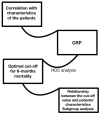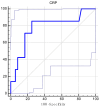Implications of Preoperative C-Reactive Protein Levels in Heart Transplant Patients-A Single-Center Retrospective Study
- PMID: 39685924
- PMCID: PMC11641936
- DOI: 10.3390/jcm13237466
Implications of Preoperative C-Reactive Protein Levels in Heart Transplant Patients-A Single-Center Retrospective Study
Abstract
Background: Heart transplant is the final therapeutic option for end-stage heart failure patients. It has been used with increasing success as a surgical procedure, greatly influenced by advances in diagnostic and prognostic tools. The aim of this paper was to study potential implications of C-reactive protein (CRP) in patients who underwent heart transplants. Methods: Our cohort included 43 adult patients from the Emergency Institute for Cardiovascular Diseases and Transplant of Târgu Mureș who underwent heart transplants in our center between 2011 and 2023. Correlations between CRP levels and different characteristics of the patients were investigated, and the optimal cut-off value for CRP levels in relation to the 6-month mortality rate was determined. The central tendencies of the baseline characteristics of patients who had a CRP value lower than the cut-off and those with a value higher than it were compared using parametric or nonparametric tests. Results: Significant correlations between the preoperative CRP levels and 6-month mortality rate (r = 0.35; 95%CI: 0.05-0.60; p = 0.02), as well as previous cardiac resynchronization therapy (CRT) and preoperative CRP levels (r = -0.37; 95%CI: -0.61--0.07, p = 0.01) were highlighted. A value for CRP > 1.66 mg/dL was found to be associated with 6-month mortality (OR = 18.00; 95%CI: 1.90-170.33, p < 0.01). Moreover, the patients who received CRT before transplantation had significantly lower levels of CRP when compared to those who did not receive CRT (p = 0.01). Conclusions: Preoperative CRP levels could represent a valuable asset in the follow-up algorithm of heart transplant patients. The lower levels of CRP in patients who benefited from CRT before transplantation highlights the importance of understanding the complex mechanisms of inflammation and increasing focus on device therapy for future transplant recipients. Further prospective studies with larger cohorts are needed for validation.
Keywords: 6-month mortality; C-reactive protein; cardiac resynchronization therapy; heart transplant; inflammation.
Conflict of interest statement
The authors declare no conflicts of interest.
Figures



References
-
- Ammar K.A., Jacobsen S.J., Mahoney D.W., Kors J.A., Redfield M.M., Burnett J.C., Jr., Rodeheffer R.J. Prevalence and Prognostic Significance of Heart Failure Stages: Application of the American College of Cardiology/American Heart Association Heart Failure Staging Criteria in the Community. Circulation. 2007;115:1563–1570. doi: 10.1161/CIRCULATIONAHA.106.666818. - DOI - PubMed
-
- Mohebi R., Wang D., Lau E.S., Parekh J.K., Allen N., Psaty B.M., Benjamin E.J., Levy D., Wang T.J., Shah S.J., et al. Effect of 2022 ACC/AHA/HFSA Criteria on Stages of Heart Failure in a Pooled Community Cohort. J. Am. Coll. Cardiol. 2023;81:2231–2242. doi: 10.1016/j.jacc.2023.04.007. Erratum in J. Am. Coll. Cardiol. 2023, 82, 1051. - DOI - PMC - PubMed
-
- Bozkurt B., Ahmad T., Alexander K.M., Baker W.L., Bosak K., Breathett K., Fonarow G.C., Heidenreich P., Ho J.E., Hsich E., et al. Heart Failure Epidemiology and Outcomes Statistics: A Report of the Heart Failure Society of America. J. Card. Fail. 2023;29:1412–1451. doi: 10.1016/j.cardfail.2023.07.006. - DOI - PMC - PubMed
-
- Bacușcă A.E., Burlacu A., Tinică G., Enache M., Ţărus A., Gavriluţă C., Brinza C., Hanganu B., Ioan B.G. Organ Procurement, Donation, and Transplant Awareness in an Urban Eastern European Region: A General Population Survey. Ann. Transplant. 2022;27:e938016. doi: 10.12659/AOT.938016. - DOI - PMC - PubMed
LinkOut - more resources
Full Text Sources
Research Materials
Miscellaneous

